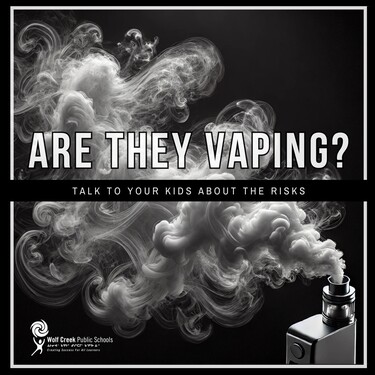Alberta Health Services

Vaping: What Parents Need to Know
Vaping is the use of a device—often called an e-cigarette—to inhale vapour that may contain nicotine, flavourings, or chemicals from cannabis. Devices can look like pens or flash drives, and they work by heating liquid or dry materials into a vapour you breathe in.
Key Safety Concerns
- Harmful Chemicals & Lung Injury: The vapour may contain chemicals linked to serious lung disease, and some vaping products with THC (cannabis) or other additives have been associated with hospitalizations and even deaths.
- Nicotine Addiction: Most vaping liquids contain nicotine—even if the label doesn’t list it. Nicotine can harm brain development in children and young adults and is highly addictive. Liquid nicotine is also poisonous if swallowed or spilled on the skin.
- Second-Hand Exposure: People nearby can be exposed to aerosols with harmful chemicals.
- Risk of Fire or Explosion: Faulty batteries and devices have been known to catch fire or explode.
Using Vaping to Quit Smoking
Some people try to quit smoking by gradually reducing the amount of nicotine they vape. But e-cigarettes are not approved as quit-smoking aids. Safer, proven methods include counseling, medicines, and nicotine replacement therapies (like patches or gum). Vaping also carries the risk of dual use, where some may continue smoking cigarettes and vape at the same time.
For more detailed information about vaping and its risks, please visit Alberta Health’s website.
Health Canada
Health Canada: Consider the Consequences of Vaping
Part of the campaign would be to use this Health Canada: Consider the Consequences of Vaping information as well to lead social media. This includes turning info into social media posts and posting premade Health Canada videos on our websites and social media.
Website Content
What’s Up with Vaping?
Vaping is sometimes seen as less harmful than smoking, but it still carries real risks—especially for youth and non-smokers. Vaping can deliver nicotine that leads to addiction, expose you to harmful chemicals, and cost more than you might expect. Research shows that it can be tough for teens to stop once they start, with peer pressure playing a major role. Canada Health has some valuable information on the harms of vaping.
Key Points to Know
- Nicotine Addiction: Vaping can deliver enough nicotine to cause cravings and dependence, especially in developing brains.
- Harmful Chemicals: The vapour may contain formaldehyde, acrolein, or metals like nickel and lead—substances linked to lung damage.
- Hidden Costs: Frequent vaping devices, pods, and liquids add up quickly.
- Quitting: Many young people who vape say they’d like to quit. Having a plan and knowing the facts can help you succeed.
- Peer Pressure: One of the most common reasons youth start vaping is social influence, making it vital to have a strategy to say “no” confidently.
Learn More
For interactive tools, videos, and more on the health effects and laws around vaping, visit: Health Canada – Youth Vaping Information
